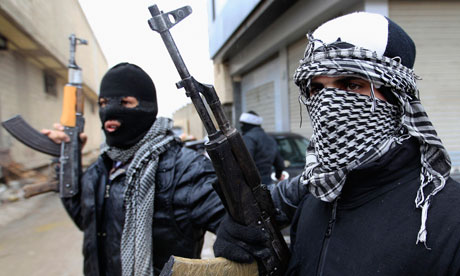By Adom M. Cooper
Impunity Watch Reporter, Middle East
DAMASCUS, Syria–As the never-ending turmoil continues in Syria, heavy fighting has erupted between opposition fighters and security forces loyal to President Bashar al-Assad in a main district of Damascus. Witnesses report that this particular area is home to several key security installations. The intense fighting is taking place as al-Assad’s regime retains the contention that it has complete control of Damascus.

Syrian state television stated three “terrorists” and a member of Syria’s security forces were killed in the fighting. Since the beginning of the uprising, the Syrian state television has continually held that these “terrorists” are to blame for the violence around the country and has not repeatedly acknowledged the many deaths endured by innocent civilians.
Rami Abdel-Rahman, head of the Syrian Observatory for Human Rights, stated that at least 18 security troops were wounded in the fighting that broke out before dawn in the upscale and heavily guarded Mazzah neighborhood of Damascus. According to the Observatory, more than 9,100 people have lost their lives since the uprising began against the regime last March. Abdel-Rahman shared these words with the AFP.
“The clashes were the strongest and closes to security installations in the capital since the outbreak of the revolt a year ago.”
A member of the Revolutionary Leadership council in Damascus, referring to herself as Lena and not wishing to be identified further, shared these words with Al-Jazeera about the fighting in Damascus.
“Some people came to al-Mezzah and they are trying to attack residents. They are calling them names and taking them out of their houses, people have left their homes. They are in the streets. The security forces are all around the place. Security police have blocked several side streets and the street lighting has been cut off.”
Mourtadad Rasheed, an activist living in Damascus, shared these words with Ahram about his encounter of the violence, detailing that heavy shooting could be heard in Mazzaeh as well as two other districts, Qaboon and Arbeen.
“We woke up at 3AM to the sound of heavy machinegun fire and rocket propelled grenades (RPG). The fighting last about 10 minute, then eased before starting again.”
Al-Jazeera’s own Rula Amin reported from neighboring Lebanon that many residents believe that opposition is pressing into areas around Damascus that could make al-Assad much more vulnerable than he already is.
“Residents are telling us that there was intense gunfire for hours. They could hear from loudspeakers the army and the security forces asking armed men to leave one of the buildings. Al-Mazzeh is not geographically located in the heart of the capital but it’s a very important neighborhood. It is heavily guarded. There are a lot of high-ranking officials living in Al-Mazzeh, in addition to the UN headquarters, embassies, and ambassadors. This is taking place as the government claims they have control over the capital.”
The most recent clashes in Syria came after twin car bombs ripped through two neighborhoods of Damascus on Saturday 17 March 2012, which according to the Syrian interior ministry, claimed 27 lives. Another car bomb was detonated on Sunday 18 March 2012 in a residential neighborhood of Aleppo, claiming two lives.
The international community continues to struggle with the appropriate and consensus response to the situation. Former UN chief Kofi Annan, who met with al-Assad in Damascus earlier this month, ordered a team of experts to Syria to discuss a possible ceasefire and an international monitoring mission. The Arab League previously deployed a monitoring mission into Syria but it was short-lived as organizational issues and turmoil on the ground prevented its success.
Technical experts from the UN and Organization of Islamic Cooperation were in Syria on Monday 19 March 2012 to assess the humanitarian impact of the regime’s deadly crackdown on the protests. The mission, with three OIC experts in the team, will cover 15 cities and will submit a report to the Saudi-based Islamic grouping and UN on the humanitarian needs of the Syrian people. OIC assistant secretary general Atta Al-Mannan Bakhit shared these words with the AFP about the mission.
“The joint OIC-UN mission entered Syria on Friday to carry out an evaluation of humanitarian aid.”
Jacob Kellenberger, president of the International Committee of the Red Cross, flew to Moscow for talks on Monday 19 March 2012 with Russian Foreign Minister Sergei Lavror on the “extremely difficult” humanitarian situation in Syria’s protests hubs.
“A daily ceasefire of at least two hours is imperative to allow the evacuation of the wounded.”
While the wounded wait for the proper attention, it would seem foolish for the international community to not pursue harsh action against al-Assad directly. The security forces are clearly following his direction and it is costing many civilians their lives. When the Arab League had its monitoring mission, it was very against the idea of foreign intervention into Syria. But at this juncture, foreign intervention seems like the only possible course of actions to serve the interests of the civilians, especially the wounded. Without intervention, more suffering is imminent.
For more information, please see:
Ahram – Damascus Rocked By Fighting After Weekend Bombings – 19 March 2012
Al-Jazeera – ‘Heavy Fighting’ Shakes Syrian Capital – 19 March 2012
BBC – Syria Unrest: Fierce Firefight Erupts In Damascus – 19 March 2012
The Guardian – Syria: ‘Heavy Fighting’ In Damascus – 19 March 2012
NYT – Fighting Flares In Elite Area of Syrian Capital, Activists Say – 19 March 2012
Reuters – Syrian Captial Sees Heavist Fighting of Uprising – 19 March 2012